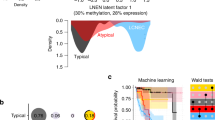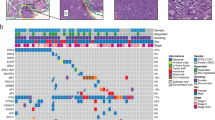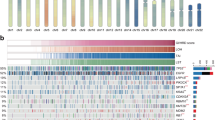Abstract
Pulmonary carcinoids are infrequent neoplasms of the lung that normally display a less aggressive biological behavior compared to small cell and non-small cell lung cancers. Approximately 15-25% of carcinoids, in particular atypical carcinoids, show lymph node metastasis and have a worse prognosis than their non-metastasized counterparts. To date, there is no morphological or molecular marker that may help to differentiate between carcinoids that metastasize and carcinoids of identical differentiation that show only local tumor growth. In this study, we analyzed 7 metastasized and 10 non-metastasized pulmonary carcinoids for chromosomal and microsatellite instability in order to determine whether microsatellite instability or chromosomal imbalances are associated with metastasis. Due to the rare occurrence of metastasized carcinoids we compared our results of chromosomal instability with the hitherto published comparative genomic hybridization (CGH) profiles of pulmonary carcinoids, for which information about the absence or presence of metastasis was available. While microsatellite instability was not detected we found chromosomal instability as a common event in pulmonary carcinoids with an increase of frequency and extent of chromosomal alterations in atypical and metastasized carcinoids. These findings are in accordance with the collected and herein compiled data of previous studies and indicate increasing numbers of chromosomal imbalances to play a role in the sequential process of tumor development and metastasis.
Similar content being viewed by others
Introduction
Carcinoids (well-differentiated endocrine tumors) are neoplasms derived from the disseminated neuroendocrine system. About 10% of all human carcinoid tumors arise in the lungs (Godwin, 1975). Pulmonary carcinoids are currently classified as typical carcinoids (TC; low grade; fewer than 2 mitoses per 2 mm2, lack of necrosis) or atypical carcinoids (ATC; intermediate grade; 2-10 mitoses per 2 mm2 and/or foci of necrosis). Although TC and ATC show subtle differences in histomorphology and although ATC tend to show a more aggressive biological behavior, both carcinoid subtypes have the potential to metastasize (Beasley et al., 2000). In a large series of 124 pulmonary carcinoids, 19 tumors had regional lymph node metastases and 12 had distant metastases (McCaughan et al., 1985). The 5- and 10-year disease-free survival rate in 19 patients who had regional lymphatic metastases were 74% and 53%, compared with 96% and 84% in those without lymph node metastases. Therefore it was concluded, that among other factors such as tumor size, patient's prognosis is strongly influenced by the status of the regional lymph nodes (McCaughan et al., 1985).
Chromosomal and microsatellite instability (CIN and MIN) are two distinct molecular mechanisms that cause DNA mutations and that underlie the pathogenesis of many epithelial tumors. Tools for the detection of gross chromosomal aberrations in a tumor with CIN on the one hand and DNA mismatch mutations on a molecular level on the other hand are comparative genomic hybridization (CGH) and PCR-based microsatellite instability (MSI) analyses, respectively. Both methods are applicable in routine, paraffin-embedded tumor material. To date, only few data are available concerning CGH and MSI analyses of pulmonary carcinoids (Hurr et al., 1996; Ullmann et al., 1998, 2002; Zhao et al., 2000; Johnen et al., 2003; Vageli et al., 2006). In these studies, chromosomal imbalances were identified both in ATC and TC, but none of these studies has investigated potential differences in chromosomal aberrations between metastasized and non-metastasized pulmonary carcinoids. The detection of specific genetic changes associated with more aggressive, metastasizing behavior and the identification of genes regulating the metastatic phenotype of pulmonary carcinoids would be helpful for both the planning of treatment strategies and patient follow-up.
We have analyzed microsatellite and chromosomal alterations in a collective of 17 metastasized and non-metastasized pulmonary carcinoids by CGH and MSI analyses. In addition, all published CGH analyses of pulmonary carcinoids were reviewed with regard to the specifications of the different alterations between metastasized and non-metastasized specimens. Our data show an evidently higher frequency of chromosomal instability in metastasized carcinoids and indicate that most carcinoids acquire a metastatic potential through accumulation of chromosomal alterations on the background of CIN.
Results
The results of our CGH analyses are summarized in Table 1. Chromosomal imbalances were found in 9 specimens (~53%) while 8 tumors (~47%) had no chromosomal imbalances detectable by conventional CGH. Two specimens showed a deletion of chromosome 11, the most common reported finding in pulmonary carcinoids. Interestingly, there were two metastasized tumors without any detectable chromosomal aberrations (Table 1) and one non-metastasized tumor with aberrations on 5 different loci (Table 1, Case 16).
Data from the meta-analysis of hitherto published CGH analyses (Walch et al., 1998; Zhao et al., 2000; Ullmann et al., 2002), including our own findings from pulmonary carcinoids, are summarized in Figure 1. In general, ATC harbour more chromosomal aberrations than TC. The frequency of CIN is evidently increased in metastasized versus non-metastasized carcinoids (gains 71% vs 51%, losses 76% vs 51%, cases with no chromosomal alterations 14% vs 31%, respectively). It is interesting to note that in contrast to non-metastasized tumors, no obvious difference in CIN frequency is found between metastasized TC and ATC (89% in TC versus 83% in ATC). Increase of chromosomal losses was found comparing TC to ATC and comparing non-metastasized to metastasized carcinoids (Figure 1). In detail, there are more gains in metastasized carcinoids compared to non-metastasized carcinoids on chromosomes 5q, 16 and 17 (Walch et al., 1998; Zhao et al., 2000; Ullmann et al., 2002). Although only revealed by one of the studies (Ullmann et al., 2002) a notable finding is the loss of chromosome 18 material exclusively in metastasized carcinoids.
MSI analyses were performed in 16 out of 17 carcinoids. We could not identify any specimen with MSI in either Cat-25, Bat-25 or Bat-26. Therefore the tumors were scored as microsatellite stable (MSS).
Discussion
Previous studies of genetic alterations in pulmonary carcinoids have focused on the differences between ATC and TC, differences between a few primary tumors and corresponding metastases, or the classification of pulmonary carcinoids within the group of neuroendocrine neoplasms of the lungs (Ullmann et al., 1998, 2002; Walch et al., 1998; Zhao et al., 2000; Johnen et al., 2003). Genetic differences between metastasized and non-metastasized pulmonary carcinoids have not been specifically addressed to date. Since lymph node or distant metastases of pulmonary carcinoids significantly influence patient survival (McCaughan et al., 1985), more information on the genetic background of tumor dissemination may be helpful to develop novel treatment and follow-up strategies. Therefore, we aimed to shed more light on differences in genetic aberrations between metastasized and non-metastasized pulmonary carcinoids. A recent study (Arnold et al., 2008) has demonstrated microsatellite instability (MSI) in some malignant neuroendocrine tumors of the intestines. In order to investigate the role of MSI in the development of pulmonary carcinoids in general and metastasis in particular we analysed the herein presented carcinoids for MSI and could exclude a significant role of this molecular mechanism for the pathogenesis and progression of carcinoids. On the other hand, our data show that CIN is frequently involved in tumor development. Moreover, the increase of CIN in metastasizing carcinoids indicates that CIN also influences tumor progression. In metastasized TC, the increase of CIN similarly affects losses and gains of chromosomal material. In metastasized ATC, the number of gains remains stable, while a significant increase of genomic losses is seen (Figure 1), indicating that loss of function mutations are involved in the process of tumor dissemination. For pancreatic endocrine neoplasms, similar observations concerning an increase of CIN in metastasized versus non-metastasized tumors were previously reported (Jonkers et al., 2005)
Our data suggest a model of carcinoid development and progression in which mitotic infidelity causes CIN at an early stage. During tumor progression, especially chromosomal losses inactivate the functions of tumor suppressor genes and promote metastatic behaviour. The fact that two metastasized carcinoids in our study lacked CIN, however, indicates that a pathway different from the acquisition of numerous gross chromosomal alterations exists. It is likely that in these tumors chromosomal imbalances beyond the sensitivity threshold of conventional CGH or small intragenic mutations in tumor suppressor genes have occurred.
Knowledge of a specific genetic alteration associated with metastasis would largely add to our understanding of the different biological behavior of pulmonary carcinoids and would enable to assess the risk of tumor dissemination by investigating biopsy material prior to surgery. We were unable to detect a chromosomal alteration with a satisfying sensitivity and specifity for metastasis in our cohort of cases. It is of note, however, that Zhao et al. (2000) described deletions at chromosome 18q in 4 of 7 metastasized carcinoids while no 18q loss was identified in non metastasized pulmonary carcinoids. Deletions of chromosome 18q are common in a variety of human malignancies. They have been described e.g. in gastrointestinal neuroendocrine tumors (carcinoids) (Zhao et al., 2000) and non-small cell lung cancer (Pan et al., 2005). Deletions of chromosome 18q are generally associated with advanced tumor stage in NSCLC (Pan et al., 2005) and have most interestingly been found in about 58% of metastasized gastrointestinal carcinoids, whereas no losses of chromosome 18q were present in non-metastasized gastrointestinal carcinoids (Zhao et al., 2000). However, our study and two previous studies (Walch et al., 1998; Ullmann et al., 2002) failed to identify chromosome 18 deletions in metastasized pulmonary carcinoids, indicating a poor sensitivity of this alteration concerning the prediction of metastatic potential.
In conclusion, we herein show that chromosomal instability is increased in atypical compared to typical and metastasized compared to non-metastasized pulmonary carcinoids. Our data suggest that chromosomal losses, in particular in ATC, lead to the inactivation of tumor suppressor genes and contribute to the metastatic capabilities of endocrine neoplasms.
Methods
Tumor samples and preparation
Samples from 10 ATC and 7 TC were investigated in this study. 5 of the ATC and 2 of the TC had regional lymph node metastases (Table 1). All tumors were surgically removed including extensive lymph node dissection in the Department of Thoracic Surgery, Heidelberg, Germany, resulting in a minimum of 11 and a maximum of 35 lymph nodes. Diagnostic radiology was performed to detect distant metastases in all cases. According to both, clinical and radiological findings, none of the patients had distant metastases. All specimens were routinely processed in the Institute for Pathology, Heidelberg University Hospital, Germany. All diagnoses were confirmed by at least two experienced pathologists and tumor typing was performed according to the current lung cancer classification from the World Health Organization (WHO) (Brambilla et al., 2001). Postoperative follow-up (maximum 6 years) was evaluated in all cases and all patients were alive and free of tumor recurrence at the time of this study.
DNA extraction
DNA used for CGH and MSI analyses was isolated from paraffin-embedded samples with a tumor content of at least 80% according to the corresponding histological slide. Genomic DNA was exclusively isolated from tumor primaries as reported previously in detail (Blaker et al., 2002).
Comparative genomic hybridization (CGH)
CGH was performed on all 17 pulmonary carcinoids as previously described in detail (Isola et al., 1994). In brief, tumor DNA was biotinylated and normal control DNA was extracted from healthy human placenta tissue and labeled with digoxigenin. After hybridization of the labeled DNA on metaphase spreads (CGH target slides, Abbot Molecular, Illinois) at 37℃ for 48 h, the slides were incubated with fluorescence-labeled anti-digoxigenin and anti-biotin antibodies. Metaphase spreads from each specimen were analyzed and photodocumented using an Axiovert S 100 microscope (Zeiss, Germany), a CCD camera, and hard- and software as supplied by Metasystems (Altlussheim, Germany). Fluorescence ratios were determined using both fixed cut-off values (0.8 for losses, 1.25 for gains) and cut-off values with a two-fold SD. Chromosomal abnormalities detected with both approaches were scored. Centromeric and telomeric chromosomal areas were excluded.
Microsatellite instability (MSI) analysis
Microsatellite marker Cat-25 (Findeisen et al., 2005) and Bethesda markers Bat-25 and Bat-26 were analyzed. Primer sequences were chosen as published previously (Findeisen et al., 2005). Microsatellite-PCR reactions were performed on microtitre plates with 9 µl reaction mixture (1 µl 10× buffer (Peqlab), 1.5 mM MgCl2, 0.5 mM dnTP, 0.5 U Taq-Polymerase (Solis Biodyne), 0.75 µM specific primers, ad 9 µl H2O) and 1 µl DNA using a Thermo Hybaid Omn-E thermal cycler (Ulm, Germany). PCR products were diluted in equal volumes of formamide buffer and denaturated at 95℃ for 1 min. Finally, PCR products were separated on 6% polyacrylamide, 8 M urea gels and visualized by silver staining.
Compilation of all available data concerning metastasized carcinoids
All published CGH analyses of pulmonary carcinoids that were clearly classifiable as "metastasized", both hematogenous and lymphogenous, or "non-metastasized" were included (Walch et al., 1998; Zhao et al., 2000; Ullmann et al., 2002). Cases without the required information were excluded, yielding a total of 21 metastasized carcinoids (12 ATC, 9TC) and 54 non-metastasized carcinoids (23 ATC, 31 TC).
Abbreviations
- CGH:
-
comparative genomic hybridization
- CIN:
-
chromosomal instability
- MIN:
-
microsatellite instability
References
Arnold CN, Nagasaka T, Goel A, Scharf I, Grabowski P, Sosnowski A, Schmitt-Gräff A, Boland CR, Arnold R, Blum HE . Molecular characteristics and predictors of survival in patients with malignant neuroendocrine tumors . Int J Cancer 2008 ; 123 : 1556 - 1564
Beasley MB, Thunnissen FB, Brambilla E, Hasleton P, Steele R, Hammar SP, Colby TV, Sheppard M, Shimosato Y, Koss MN, Falk R, Travis WD . Pulmonary atypical carcinoid: predictors of survival in 106 cases . Hum Pathol 2000 ; 31 : 1255 - 1265
Blaker H, von Herbay A, Penzel R, Gross S, Otto HF . Genetics of adenocarcinomas of the small intestine: frequent deletions at chromosome 18q and mutations of the SMAD4 gene . Oncogene 2002 ; 21 : 158 - 164
Brambilla E, Travis WD, Colby TV, Corrin B, Shimosato Y . The new World Health Organization classification of lung tumours . Eur Respir J 2001 ; 18 : 1059 - 1068
Findeisen P, Kloor M, Merx S, Sutter C, Woerner SM, Dostmann N, Benner A, Dondog B, Pawlita M, Dippold W, Wagner R, Gebert J, von Knebel Doeberitz M . T25 repeat in the 3' untranslated region of the CASP2 gene: a sensitive and specific marker for microsatellite instability in colorectal cancer . Cancer Res 2005 ; 65 : 8072 - 8078
Godwin JD . Carcinoid tumors. An analysis of 2,837 cases . Cancer 1975 ; 36 : 560 - 569
Hurr K, Kemp B, Silver SA, el-Naggar AK . Microsatellite alteration at chromosome 3p loci in neuroendocrine and non-neuroendocrine lung tumors. Histogenetic and clinical relevance . Am J Pathol 1996 ; 149 : 613 - 620
Isola J, DeVries S, Chu L, Ghazvini S, Waldman F . Analysis of changes in DNA sequence copy number by comparative genomic hybridization in archival paraffin-embedded tumor samples . Am J Pathol 1994 ; 145 : 1301 - 1308
Johnen G, Krismann M, Jaworska M, Muller KM . CGH findings in neuroendocrine tumours of the lung . Pathologe 2003 ; 24 : 303 - 307
Jonkers YM, Claessen SM, Perren A, Schmid S, Komminoth P, Verhofstad AA, Hofland LJ, de Krijger RR, Slootweg PJ, Ramaekers FC, Speel EJ . Chromosomal instability predicts metastatic disease in patients with insulinomas . Endocr Relat Cancer 2005 ; 12 : 435 - 447
McCaughan BC, Martini N, Bains MS . Bronchial carcinoids. Review of 124 cases . J Thorac Cardiovasc Surg 1985 ; 89 : 8 - 17
Pan H, Califano J, Ponte JF, Russo AL, Cheng KH, Thiagalingam A, Nemani P, Sidransky D, Thiagalingam S . Loss of heterozygosity patterns provide fingerprints for genetic heterogeneity in multistep cancer progression of tobacco smoke-induced non-small cell lung cancer . Cancer Res 2005 ; 65 : 1664 - 1669
Ullmann R, Schwendel A, Klemen H, Wolf G, Petersen I, Popper HH . Unbalanced chromosomal aberrations in neuroendocrine lung tumors as detected by comparative genomic hybridization . Hum Pathol 1998 ; 29 : 1145 - 1149
Ullmann R, Petzmann S, Klemen H, Fraire AE, Hasleton P, Popper HH . The position of pulmonary carcinoids within the spectrum of neuroendocrine tumors of the lung and other tissues . Genes Chromosomes Cancer 2002 ; 34 : 78 - 85
Vageli D, Daniil Z, Dahabreh J, Karagianni E, Liloglou T, Koukoulis G, Gourgoulianis K . Microsatellite instability and loss of heterozygosity at the MEN1 locus in lung carcinoid tumors: a novel approach using real-time PCR with melting curve analysis in histopathologic material . Oncol Rep 2006 ; 15 : 557 - 564
Walch AK, Zitzelsberger HF, Aubele MM, Mattis AE, Bauchinger M, Candidus S, Prauer HW, Werner M, Hofler H . Typical and atypical carcinoid tumors of the lung are characterized by 11q deletions as detected by comparative genomic hybridization . Am J Pathol 1998 ; 153 : 1089 - 1098
Zhao J, de Krijger RR, Meier D, Speel EJ, Saremaslani P, Muletta-Feurer S, Matter C, Roth J, Heitz PU, Komminoth P . Genomic alterations in well-differentiated gastrointestinal and bronchial neuroendocrine tumors (carcinoids): marked differences indicating diversity in molecular pathogenesis . Am J Pathol 2000 ; 157 : 1431 - 1438
Acknowledgements
A.W. was supported by the Postdoc-Programm of the Medical Faculty of Heidelberg University. This project was supported by the tissue bank of the National Cancer Center (NCT) of Heidelberg.
Author information
Authors and Affiliations
Corresponding author
Rights and permissions
This is an Open Access article distributed under the terms of the Creative Commons Attribution Non-Commercial License (http://creativecommons.org/licenses/by-nc/3.0/) which permits unrestricted non-commercial use, distribution, and reproduction in any medium, provided the original work is properly cited.
About this article
Cite this article
Warth, A., Herpel, E., Krysa, S. et al. Chromosomal instability is more frequent in metastasized than in non-metastasized pulmonary carcinoids but is not a reliable predictor of metastatic potential. Exp Mol Med 41, 349–353 (2009). https://doi.org/10.3858/emm.2009.41.5.039
Accepted:
Published:
Issue Date:
DOI: https://doi.org/10.3858/emm.2009.41.5.039
Keywords
This article is cited by
-
Morphologic and molecular classification of lung neuroendocrine neoplasms
Virchows Archiv (2021)
-
Diagnose, Prognose und Prädiktion nicht-kleinzelliger Lungenkarzinome
Der Pathologe (2015)
-
Pulmonale neuroendokrine Tumoren in der neuen WHO-Klassifikation 2015
Der Pathologe (2015)
-
Neuroendokrine Tumoren der Lunge
Der Pathologe (2014)
-
Molekularpathologie des Lungenkarzinoms
Der Pathologe (2014)




